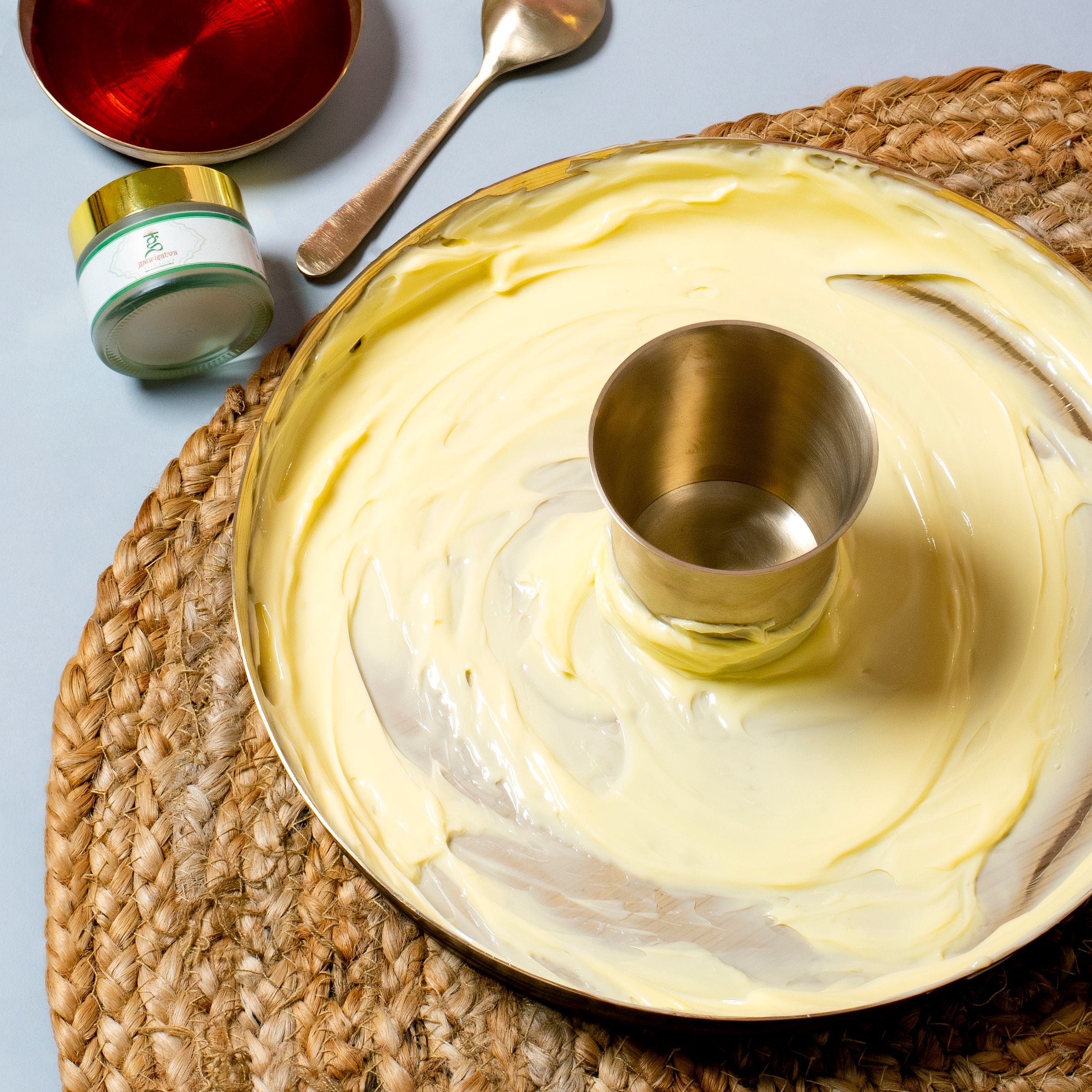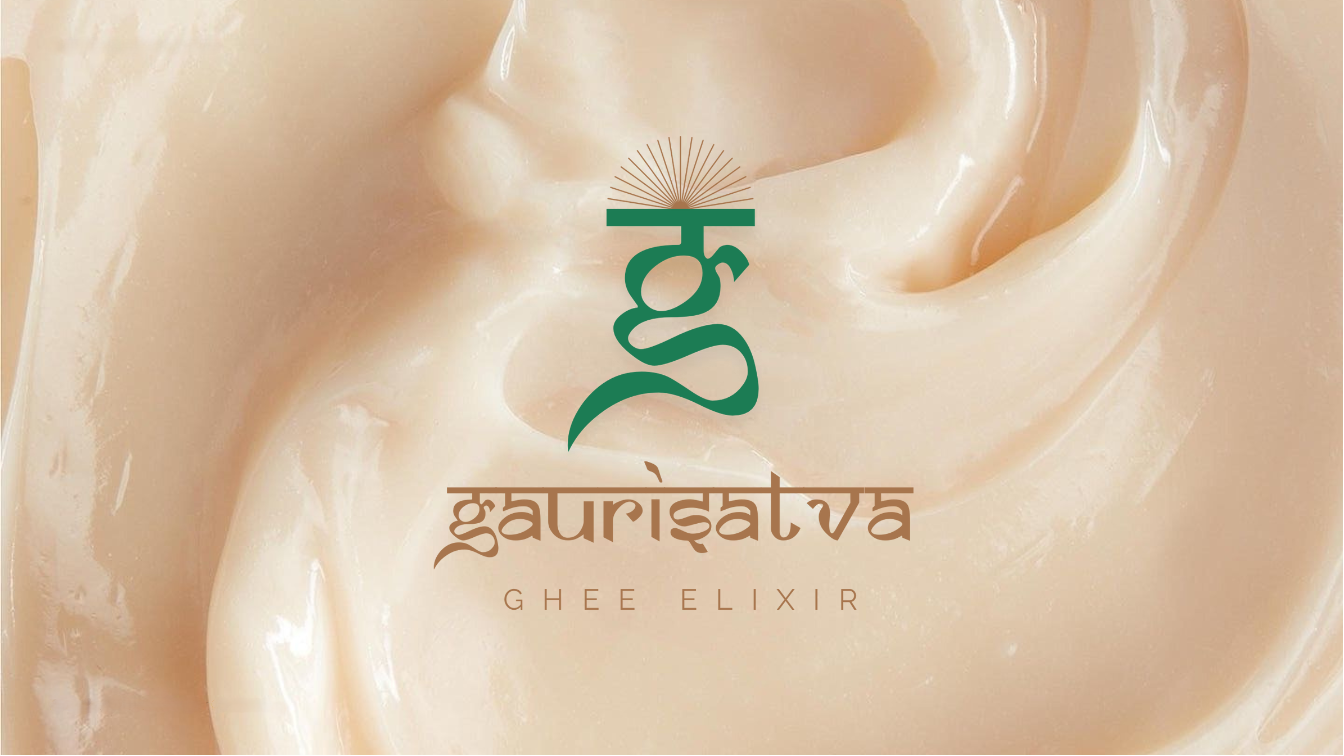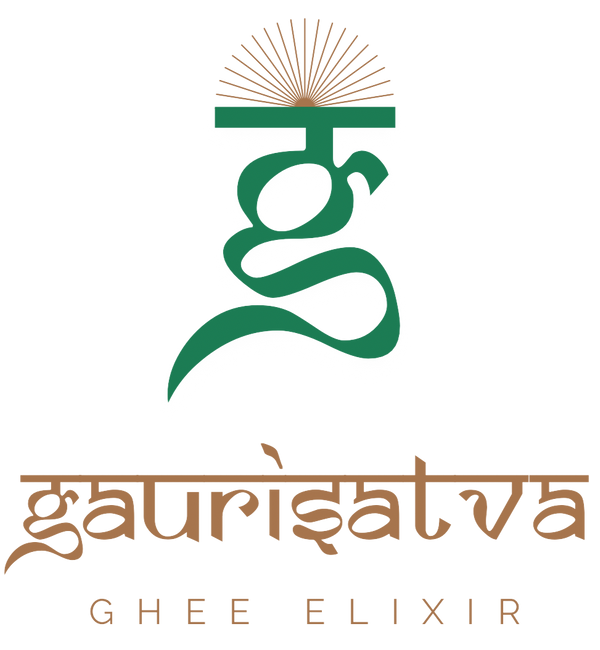Shata Dhauta Ghrita (SDG)

Shata Dhauta Ghrita (SDG) is a symbol of the profound heritage of Ayurveda, an ancient
system of medicine deeply entrenched in Indian culture. Derived from cow ghee, SDG
undergoes a meticulous process of being washed one hundred times with purified water in a
copper vessel, accompanied by Vedic mantras. This ritual results in a luxurious, odorless
cream known for its remarkable ability to penetrate all seven layers of the skin without
clogging pores, offering unparalleled nourishment and rejuvenation.
Scriptural References and Ancient Texts
Shata Dhauta Ghrita (SDG) finds mention in several ancient Ayurvedic scriptures, where its preparation method and therapeutic benefits are described in detail. The Charaka Samhita, one of the foundational texts of Ayurveda dating back to around 1000 BCE, provides insights into the medicinal properties of ghee-based preparations, including SDG. Similarly, the Sushruta Samhita, another seminal text on Ayurvedic medicine, elucidates the uses of ghee in skincare and wound healing, highlighting its efficacy in promoting tissue regeneration and skin rejuvenation. In addition to these classical Ayurvedic texts, references to ghee-based preparations can also be found in other ancient Indian scriptures and philosophical treatises. The Atharva Veda, for example, mentions the use of ghee in rituals and ceremonies, underscoring its sacred significance in Hindu culture.

Names and Variants
Shata Dhauta Ghrita is known by various names in different regions and traditions. In Sanskrit, “Shata” means one hundred, “Dhauta” means washed, and “Ghrita” refers to clarified butter or ghee. Other names for this elixir include “Hundredfold Washed Ghee” and “Purified Butter.” Variants of Shata Dhauta Ghrita may include additional ingredients or variations in the washing process, but the essence remains the same.
Collapsible content
India
In India, Shata Dhauta Ghrita holds a revered place in Ayurvedic medicine and skincare rituals. It is used in traditional beauty treatments, such as Abhyanga (oil massage) and Shirodhara (forehead oil flow), to nourish and rejuvenate the skin. The practice of applying Shata Dhauta Ghrita is believed to promote healthy skin, calm the mind, and enhance overall well-being. It is also used in religious ceremonies and rituals for purification and offering to deities.
Egypt
In ancient Egypt, ghee was prized for its medicinal and cosmetic properties. Ghee-based preparations were commonly used in skincare rituals, including moisturizing the skin and protecting it from the harsh desert climate. Ghee was also used in religious ceremonies and offerings to gods and goddesses.
Persia
Ghee-based remedies were embraced in ancient Persia (modern-day Iran), where they were known as “gur” and were used both internally and externally for health and wellness. In Persia, ghee has been used for centuries in traditional medicine and culinary practices. Ghee was valued for its therapeutic properties, including its ability to nourish the skin and promote overall health. It was also incorporated into Persian cuisine, adding richness and
flavor to various dishes.
China
In traditional Chinese medicine, ghee-based preparations have been used for centuries for their therapeutic properties. In China, ghee was known as “huangyou” and was valued for its medicinal properties in traditional Chinese medicine. Ghee is valued for its moisturizing and nourishing effects on the skin. It is often incorporated into skincare products and massage oils to promote skin health and vitality.
Greece
Ancient Greek civilization also valued the use of ghee for its medicinal and cosmetic benefits. Ghee was commonly used in skincare rituals, including moisturizing and protecting the skin from environmental damage. It was also used in cooking and religious ceremonies, symbolizing purity and abundance.
Ritualistic Practices and Spiritual Significance
The preparation of Shata Dhauta Ghrita is steeped in ritualistic practices and spiritual beliefs, reflecting the reverence for tradition and the interconnectedness of the physical and metaphysical realms. The use of copper vessels, purified water, and Vedic mantras in the washing process is symbolic of purification on multiple levels, ensuring that the final product is free from impurities and infused with divine blessings. Each step in the preparation of SDG, from the washing of the ghee to the chanting of mantras, is imbued with spiritual significance and cultural symbolism. The repetition of washing the ghee one hundred times underscores the dedication and meticulousness required in Ayurvedic medicine, while the chanting of mantras invokes divine blessings and positive vibrations, elevating the healing properties of the preparation to a higher realm.
Traditional Uses and Therapeutic Properties in Skincare
Shata Dhauta Ghrita (SDG) has been revered in Ayurvedic skincare for centuries, celebrated for its multifaceted therapeutic properties and remarkable efficacy in addressing various dermatological concerns. Derived from cow ghee, SDG undergoes a meticulous purification process involving washing the ghee one hundred times with purified water in copper vessels, accompanied by Vedic mantras. This sacred ritual not only enhances the purity of SDG but also imbues it with spiritual significance, elevating its healing potential.
Deep Nourishment and Skin Rejuvenation
SDG's ability to penetrate all seven layers of the skin without clogging pores makes it an exceptional moisturizer and emollient. Its rich lipid content deeply nourishes and hydrates the skin, replenishing moisture and restoring elasticity. This deep hydration promotes skin rejuvenation, reducing the appearance of fine lines, wrinkles, and dryness. Regular application of SDG results in a visibly smoother, softer, and more radiant complexion.
Antioxidant Protection and Anti-Inflammatory Benefits
The washing process enhances SDG's antioxidant properties, providing the skin with vital protection against oxidative stress and environmental damage. Antioxidants neutralize free radicals, preventing premature aging and supporting skin health. Additionally, SDG exhibits potent anti inflammatory effects, soothing irritation, redness, and inflammation associated
with conditions such as eczema, psoriasis, and dermatitis. Its calming properties promote skin healing and balance, restoring comfort and vitality to compromised skin.
Balancing and Restoring Skin Health
SDG's neutral pH and gentle formulation make it suitable for all skin types, including
sensitive and reactive skin. Its soothing properties help rebalance the skin's natural barrier function, reducing sensitivity and improving resilience. Whether used as a daily moisturizer, overnight treatment, or targeted remedy for specific concerns, SDG promotes overall skin health and well-being. Its ability to address multiple skincare issues simultaneously makes it a versatile and indispensable addition to any skincare routine.
Integration into Modern-Day Ayurveda
In contemporary Ayurvedic skincare practices, Shata Dhauta Ghrita remains a cornerstone of holistic wellness and beauty. Ayurvedic practitioners integrate SDG into personalized skincare regimens and therapeutic treatments, harnessing its potent properties to address
individual skin concerns. From luxurious spa rituals to at-home skincare rituals, SDG offers a holistic approach to skincare that aligns with Ayurveda's principles of balance, harmony, and natural healing. Its timeless wisdom and proven efficacy continue to inspire innovation and research in the field of skincare, driving the evolution of Ayurvedic beauty rituals for modern lifestyles.
